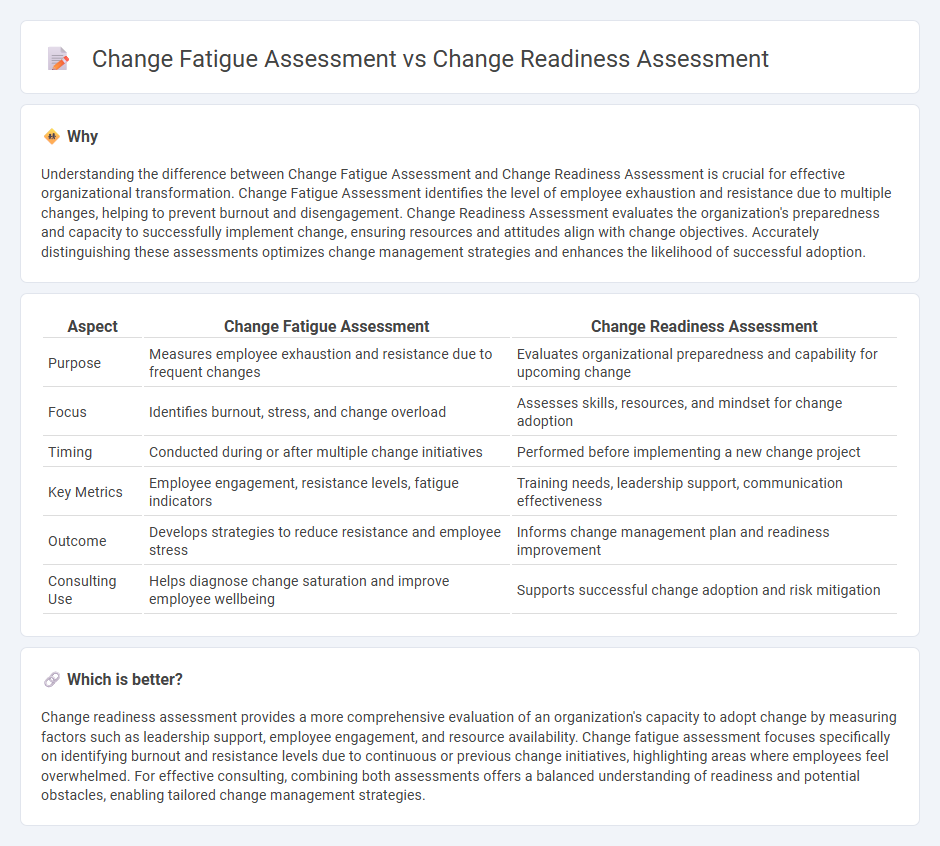
Change fatigue assessment evaluates the extent to which employees feel overwhelmed and resistant due to continuous organizational changes, measuring stress levels and engagement decline. Change readiness assessment identifies the preparedness of an organization and its workforce to successfully implement new initiatives by analyzing skills, resources, and cultural alignment. Discover how these assessments drive effective change management strategies and enhance organizational resilience.
Why it is important
Understanding the difference between Change Fatigue Assessment and Change Readiness Assessment is crucial for effective organizational transformation. Change Fatigue Assessment identifies the level of employee exhaustion and resistance due to multiple changes, helping to prevent burnout and disengagement. Change Readiness Assessment evaluates the organization's preparedness and capacity to successfully implement change, ensuring resources and attitudes align with change objectives. Accurately distinguishing these assessments optimizes change management strategies and enhances the likelihood of successful adoption.
Comparison Table
| Aspect | Change Fatigue Assessment | Change Readiness Assessment |
|---|---|---|
| Purpose | Measures employee exhaustion and resistance due to frequent changes | Evaluates organizational preparedness and capability for upcoming change |
| Focus | Identifies burnout, stress, and change overload | Assesses skills, resources, and mindset for change adoption |
| Timing | Conducted during or after multiple change initiatives | Performed before implementing a new change project |
| Key Metrics | Employee engagement, resistance levels, fatigue indicators | Training needs, leadership support, communication effectiveness |
| Outcome | Develops strategies to reduce resistance and employee stress | Informs change management plan and readiness improvement |
| Consulting Use | Helps diagnose change saturation and improve employee wellbeing | Supports successful change adoption and risk mitigation |
Which is better?
Change readiness assessment provides a more comprehensive evaluation of an organization's capacity to adopt change by measuring factors such as leadership support, employee engagement, and resource availability. Change fatigue assessment focuses specifically on identifying burnout and resistance levels due to continuous or previous change initiatives, highlighting areas where employees feel overwhelmed. For effective consulting, combining both assessments offers a balanced understanding of readiness and potential obstacles, enabling tailored change management strategies.
Connection
Change fatigue assessment identifies employee exhaustion and resistance caused by continuous organizational changes, while change readiness assessment evaluates the preparedness and willingness of individuals and teams to adopt new initiatives. Both assessments provide critical insights into the organization's capacity for successful transformation, enabling consultants to tailor communication strategies and interventions. Integrating these tools helps mitigate risks of project delays and improves overall change management effectiveness.
Key Terms
Stakeholder Engagement
Change readiness assessment evaluates stakeholders' willingness and ability to support organizational change by measuring awareness, commitment, and resource availability. Change fatigue assessment identifies signs of burnout, resistance, and emotional exhaustion stemming from continuous change efforts, emphasizing the need to address stakeholder morale and engagement levels. Explore effective strategies to balance readiness and fatigue for sustained stakeholder engagement and successful change implementation.
Organizational Capacity
Change readiness assessment evaluates an organization's ability to successfully implement change by analyzing factors like leadership support, employee engagement, and resource availability. Change fatigue assessment measures the extent of employee exhaustion and decreased motivation due to frequent or poorly managed organizational changes, impacting overall capacity. Explore our comprehensive insights to better understand how these assessments influence organizational capacity.
Employee Morale
Change readiness assessment evaluates employees' willingness, capability, and enthusiasm to embrace organizational changes, providing insights into their motivation and overall morale. Change fatigue assessment measures the emotional and physical exhaustion caused by continuous or overwhelming changes, highlighting signs of decreased morale and engagement. Explore detailed strategies and tools to effectively measure and improve employee morale during transitions.
Source and External Links
How To Conduct a Change Readiness Assessment [+ Template] - A change readiness assessment evaluates if an organization and its people understand, want, and are able to adopt a change, focusing on key aspects such as awareness, motivation, and knowledge, aligned with models like Prosci's ADKAR and Kotter's 8-Step Change Model.
How to Conduct a Change Readiness Assessment - Whatfix - Conducting a change readiness assessment involves identifying the objectives and scope of changes, collecting data about organizational culture, past change history, employee skills, and willingness to adapt, to measure how ready and able the team is to embrace change.
How to Use a Readiness Assessment For Change Management - A change readiness assessment helps determine an organization's preparedness to implement change by analyzing data from leadership, employee surveys, and cultural assessments to identify gaps and develop targeted strategies for successful transformation.
 dowidth.com
dowidth.com